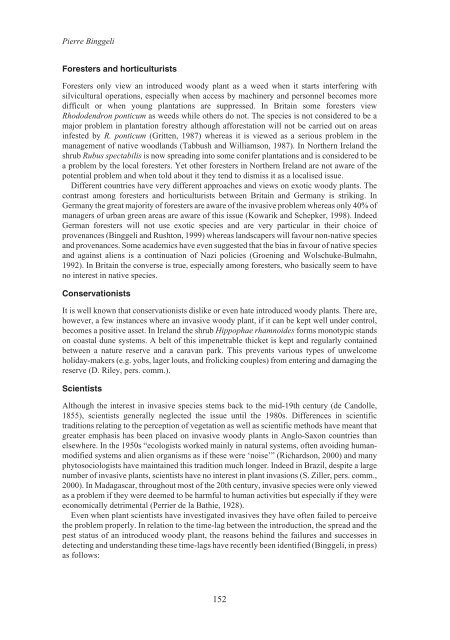Alien Species.vp - IUCN
Alien Species.vp - IUCN
Alien Species.vp - IUCN
You also want an ePaper? Increase the reach of your titles
YUMPU automatically turns print PDFs into web optimized ePapers that Google loves.
Pierre Binggeli<br />
Foresters and horticulturists<br />
Foresters only view an introduced woody plant as a weed when it starts interfering with<br />
silvicultural operations, especially when access by machinery and personnel becomes more<br />
difficult or when young plantations are suppressed. In Britain some foresters view<br />
Rhododendron ponticum as weeds while others do not. The species is not considered to be a<br />
major problem in plantation forestry although afforestation will not be carried out on areas<br />
infested by R. ponticum (Gritten, 1987) whereas it is viewed as a serious problem in the<br />
management of native woodlands (Tabbush and Williamson, 1987). In Northern Ireland the<br />
shrub Rubus spectabilis is now spreading into some conifer plantations and is considered to be<br />
a problem by the local foresters. Yet other foresters in Northern Ireland are not aware of the<br />
potential problem and when told about it they tend to dismiss it as a localised issue.<br />
Different countries have very different approaches and views on exotic woody plants. The<br />
contrast among foresters and horticulturists between Britain and Germany is striking. In<br />
Germany the great majority of foresters are aware of the invasive problem whereas only 40% of<br />
managers of urban green areas are aware of this issue (Kowarik and Schepker, 1998). Indeed<br />
German foresters will not use exotic species and are very particular in their choice of<br />
provenances (Binggeli and Rushton, 1999) whereas landscapers will favour non-native species<br />
and provenances. Some academics have even suggested that the bias in favour of native species<br />
and against aliens is a continuation of Nazi policies (Groening and Wolschuke-Bulmahn,<br />
1992). In Britain the converse is true, especially among foresters, who basically seem to have<br />
no interest in native species.<br />
Conservationists<br />
It is well known that conservationists dislike or even hate introduced woody plants. There are,<br />
however, a few instances where an invasive woody plant, if it can be kept well under control,<br />
becomes a positive asset. In Ireland the shrub Hippophae rhamnoides forms monotypic stands<br />
on coastal dune systems. A belt of this impenetrable thicket is kept and regularly contained<br />
between a nature reserve and a caravan park. This prevents various types of unwelcome<br />
holiday-makers (e.g. yobs, lager louts, and frolicking couples) from entering and damaging the<br />
reserve (D. Riley, pers. comm.).<br />
Scientists<br />
Although the interest in invasive species stems back to the mid-19th century (de Candolle,<br />
1855), scientists generally neglected the issue until the 1980s. Differences in scientific<br />
traditions relating to the perception of vegetation as well as scientific methods have meant that<br />
greater emphasis has been placed on invasive woody plants in Anglo-Saxon countries than<br />
elsewhere. In the 1950s “ecologists worked mainly in natural systems, often avoiding humanmodified<br />
systems and alien organisms as if these were ‘noise’” (Richardson, 2000) and many<br />
phytosociologists have maintained this tradition much longer. Indeed in Brazil, despite a large<br />
number of invasive plants, scientists have no interest in plant invasions (S. Ziller, pers. comm.,<br />
2000). In Madagascar, throughout most of the 20th century, invasive species were only viewed<br />
as a problem if they were deemed to be harmful to human activities but especially if they were<br />
economically detrimental (Perrier de la Bathie, 1928).<br />
Even when plant scientists have investigated invasives they have often failed to perceive<br />
the problem properly. In relation to the time-lag between the introduction, the spread and the<br />
pest status of an introduced woody plant, the reasons behind the failures and successes in<br />
detecting and understanding these time-lags have recently been identified (Binggeli, in press)<br />
as follows:<br />
152












